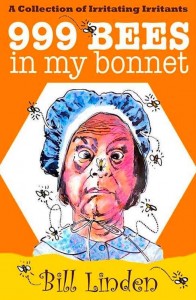One of my favorite things about freelancing is the sheer number of ways people can make a living off of the written word. A friend of mine, Bill Linden, is a gag writer and writes some of the jokes you see in the comics each week.

Ever since we met I’ve been curious about being a professional gag writer, so I asked Bill to answer a few questions. Being funny for money isn’t easy, but Bill is making it work by leveraging his connections and writing tons of gags. Bill shared his insight and a handful of the gags he has written. Enjoy!

Q: How long have you been writing gags and how did you get started as a gag writer?
A: In the mid 1980’s my wife worked with Pulitzer Prize winning editorial
cartoonist Jeff MacNelly’s third wife, Scottie. The four of us would often go out
together and have fun. Jeff had started the comic strip “Shoe” in 1977. As a lark I wrote some and he bought two. I was paid $25 each. He gave me the original,
which now hangs proudly in our “Elvis/Beatles/Pop Culture” “Guest Suite.” Jeff & Scotty went their separate ways, as did our foursome. I was having brunch with Scottie in late 1999 and she mentioned Jeff was really sick and why don’t I send him some gags. I did and he liked what I sent in. Unfortunately he passed away way too young in the middle of 2000. The strip was continued on by Susie MacNelly (Jeff’s fourth wife), Chris Cassatt (producer) and Gary Brookins (he draws it). They decided to keep me on as one of the gag writers. I send 85 gags to them a week, here is is example of what my gags look like that I send:
B17–Scene: Sky & Cosmo at home watching TV…
Panel 1: Sky: “Uncle Cosmo?”
Cosmo: “Yes?”
Panel 2: Sky: “What reality shows did you have as a kid?”
Cosmo: “The 10 O’Clock news.”
We have a six-week lead time which is why most comic strips aren’t that topical. If I write a gag about something that happens today, it most likely won’t be
relevant six weeks from today (exception to the rule: insert wacky Republican
hijinx gag here…).
 Q: How did/do you connect with the cartoons you write for?
Q: How did/do you connect with the cartoons you write for?
A: When Johnny Hart passed away (creator of B.C. & “Wizard Of Id”) in 2007 the Hart family asked my “Shoe” people if I’d like to write for them also, my “Shoe” people asked me if I would like to and I said sure if they didn’t mind. They didn’t mind. I usually try to send the Hart family 50 gags a week (25 B.C. & 25 “Wizard of Id”).
 Q: What is the process for pitching?
Q: What is the process for pitching?
A: It is a hard business to break into. As you read I only got into by
knowing the people involved then being recommended by them to others. I have
tried contacting other cartoonists (because I have a backlog of ten years of
unsold gags) through their syndicates, through snail mail or email, and the results
have been very disappointing. Either they don’t want to deal with the hassle of
buying freelance gags or they prefer writing them themselves. OR they don’t
want to pay or pay very little. The going rate today is around $75-$100 a gag if
they buy it. Although one strip that I won’t mention (or I would ever write for
again) paid me $20 not that long ago!
 Q: I am sure it is a lot harder than people think to be funny for money. What are some tips you can offer for people who are looking to get into comedy writing?
Q: I am sure it is a lot harder than people think to be funny for money. What are some tips you can offer for people who are looking to get into comedy writing?
A: DON’T!!! But if you must… Get a THICK SKIN!!! Gag writing is NOT for the faint-hearted folk who take rejection personally. Out of the 85 gags I send in a week, I’m lucky if I average THREE sold (that’s 82 unsold that go in the files!)
A: What’s a blog?
Q: You are a great entertainer on Facebook. How do people find you on FB?
A: People can find me on Facebook under “Bill Linden.” There’s lots of Bill Lindens but I’m the only one with a profile picture of me standing between Marilyn Monroe’s legs looking up her skirt. But hurry. There’s a 5,000 friend limit and I already have 873!
 About Bill: Bill’s occupations in previous lives include bitter and disillusioned graphic designer/art director for the Chicago Sun-Times, bitter and disillusioned
About Bill: Bill’s occupations in previous lives include bitter and disillusioned graphic designer/art director for the Chicago Sun-Times, bitter and disillusioned
Hollywood screenwriter, and a bitter and disillusioned gag writer for comic strips. When not writing gags, photographing Chicago or being bitter and disillusioned, Bill finds his charity work with the elderly quite rewarding. Once a week he takes his dear, feeble, white-haired mother, Josephine, to Denny’s® for a “Moons Over My Hammy”®. Once every six weeks, he even buys.” Bill lives by the mottos, “If you can’t beat ’em, mock ’em!” and “That what does not kill me makes me bitter and disillusioned.”
 About Bill’s book: Bill’s many adventures have taught him a lot—about what drives him nuts! He’s excited to share, for your reading pleasure, 999 Bees in My Bonnet: A Collection of Irritating Irritants. Whether it’s the double-crossing staff at Traitor Joe’s, reptile dysfunction, “Northern” fried chicken, or seven-year jock itch, Bill’s got a gripe to crack you up. There may be bees in his bonnet, but boy, are they makin’ honey! It is available on SmashWords or Amazon.
About Bill’s book: Bill’s many adventures have taught him a lot—about what drives him nuts! He’s excited to share, for your reading pleasure, 999 Bees in My Bonnet: A Collection of Irritating Irritants. Whether it’s the double-crossing staff at Traitor Joe’s, reptile dysfunction, “Northern” fried chicken, or seven-year jock itch, Bill’s got a gripe to crack you up. There may be bees in his bonnet, but boy, are they makin’ honey! It is available on SmashWords or Amazon.



.jpg)